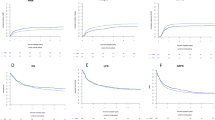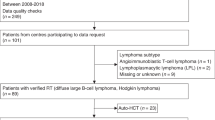Abstract
Allogeneic hematopoietic stem cell transplantation (alloHSCT) has become a well-established treatment option for many patients suffering from malignant and non-malignant diseases. In the past decade, high-resolution HLA-typing, remission surveillance, pre-emptive immune intervention, and standardisation in supportive care measures have substantially improved transplant outcomes. This retrospective study evaluated transplant procedures in 162 paediatric patients with acute lymphoblastic leukaemia (n = 124) or acute myeloid leukaemia (n = 38) who received their first alloHSCT in our institution over an 11-year period. We observed a significant reduction in risk of non-relapse mortality (NRM) over time (HR = 0.34, 95% CI 0.12–0.98; P = 0.05), the 4-year NRM estimate decreased from 20% in 2005–2008 to 7% in 2012–2016 (P = 0.02) and an increase in survival after relapse. There was no significant difference in patients who received a graft from a sibling, haplo, or an unrelated donor with regard to their overall survival (P = 0.45), event-free survival (P = 0.61), and non-relapse mortality (P = 0.19). Our data suggest that a specific transplant infrastructure with a highly experienced team in an accredited transplant centre likely contributes to better transplant outcomes for acute leukaemia patients in complete remission regardless of donor type.
This is a preview of subscription content, access via your institution
Access options
Subscribe to this journal
Receive 12 print issues and online access
$259.00 per year
only $21.58 per issue
Buy this article
- Purchase on Springer Link
- Instant access to full article PDF
Prices may be subject to local taxes which are calculated during checkout





Similar content being viewed by others
References
Copelan EA. Hematopoietic Stem-Cell Transplantation. N Engl J Med. 2006;354:1813–26.
Seggewiss R, Einsele H. Immune reconstitution after allogeneic transplantation and expanding options for immunomodulation: an update. Blood. 2010;115:3861–8.
Huenecke S, Cappel C, Esser R, Pfirrmann V, Salzmann-Manrique E, Betz S, et al. Development of Three Different NK Cell Subpopulations during Immune Reconstitution after Pediatric Allogeneic Hematopoietic Stem Cell Transplantation: Prognostic Markers in GvHD and Viral Infections. Front Immunol. 2017;8. http://journal.frontiersin.org/article/10.3389/fimmu.2017.00109/full. Accessed 19 Nov 2017.
Bader P, Kreyenberg H, Henze GHR, Eckert C, Reising M, Willasch A, et al. Prognostic value of minimal residual disease quantification before allogeneic stem-cell transplantation in relapsed childhood acute lymphoblastic leukemia: the ALL-REZ BFM Study Group. J Clin Oncol J Am Soc Clin Oncol. 2009;27:377–84.
Bader P, Kreyenberg H, Hoelle W, Dueckers G, Handgretinger R, Lang P, et al. Increasing mixed chimerism is an important prognostic factor for unfavorable outcome in children with acute lymphoblastic leukemia after allogeneic stem-cell transplantation: possible role for pre-emptive immunotherapy? J Clin Oncol J Am Soc Clin Oncol. 2004;22:1696–705.
Bader P, Kreyenberg H, von Stackelberg A, Eckert C, Salzmann-Manrique E, Meisel R, et al. Monitoring of minimal residual disease after allogeneic stem-cell transplantation in relapsed childhood acute lymphoblastic leukemia allows for the identification of impending relapse: results of the ALL-BFM-SCT 2003 trial. J Clin Oncol J Am SocClin Oncol. 2015;33:1275–84.
Rettinger E, Merker M, Salzmann-Manrique E, Kreyenberg H, Krenn T, Dürken M, Faber J, Huenecke S, Cappel C, Bremm M, Willasch A, Bakhtiar S, Jarisch A, Soerensen J, Klingebiel T, Bader P.Biol Blood Marrow Transplant. 2017;23:87–95. https://doi.org/10.1016/j.bbmt.2016.10.006. [Epub 2016 Oct 11.PMID:27742575].
Willasch AM, Salzmann-Manrique E, Krenn T, Duerken M, Faber J, Opper J, Kreyenberg H, Bager R, Huenecke S, Cappel C, Bremm M, Pfirrmann V, Merker M, Ullrich E, Bakhtiar S, Rettinger E, Jarisch A, Soerensen J, Klingebiel TE, Bader P.Bone Marrow Transplant. 2017;52:201–8. https://doi.org/10.1038/bmt.2016.224. Epub 2016 Sep 19.PMID:27643863
Passweg JR, Baldomero H, Bader P, Bonini C, Cesaro S, Dreger P, et al. Hematopoietic stem cell transplantation in Europe 2014: more than 40 000 transplants annually. Bone Marrow Transplant. 2016;51:786–92.
Gratwohl A, Pasquini MC, Aljurf M, Atsuta Y, Baldomero H, Foeken L, et al. One million haemopoietic stem-cell transplants: a retrospective observational study. Lancet Haematol. 2015;2:e91–100.
Brissot E, Rialland F, Cahu X, Strullu M, Corradini N, Thomas C, et al. Improvement of overall survival after allogeneic hematopoietic stem cell transplantation for children and adolescents: a three-decade experience of a single institution. Bone Marrow Transplant. 2016;51:267–72.
Gratwohl A, Sureda A, Baldomero H, Gratwohl M, Dreger P, Kröger N, et al. Economics and outcome after hematopoietic stem cell transplantation: a retrospective cohort study. EBioMedicine. 2015;2:2101–9.
Gratwohl A, Brand R, McGrath E, van Biezen A, Sureda A, Ljungman P, et al. Use of the quality management system “JACIE” and outcome after hematopoietic stem cell transplantation. Haematologica. 2014;99:908–15.
Klingebiel T, Handgretinger R, Lang P, Bader P, Niethammer D. Haploidentical transplantation for acute lymphoblastic leukemia in childhood. Blood Rev. 2004;18:181–92.
Warlick ED, Peffault de Latour R, Shanley R, Robin M, Bejanyan N, Xhaard A, et al. Allogeneic hematopoietic cell transplantation outcomes in acute myeloid leukemia: similar outcomes regardless of donor type. Biol Blood Marrow Transplant J Am Soc Blood Marrow Transplant. 2015;21:357–63.
Yanada M, Kurosawa S, Yamaguchi T, Uchida N, Miyawaki S, Kanamori H, et al. Effect of related donor availability on outcome of AML in the context of related and unrelated hematopoietic cell transplantation. Bone Marrow Transplant. 2013;48:390–5.
Jindra P, Muzik J, Indrak K, Zak P, Sabty FA, Kozak T, et al. The outcome of allogeneic HSCT in older AML patients is determined by disease biology and not by the donor type: an analysis of 96 allografted AML patients ≥ 50 years from the Czech acute leukaemia clinical register (alert). Neoplasma. 2013;60:576–83.
Peters C, Schrappe M, von Stackelberg A, Schrauder A, Bader P, Ebell W, et al. Stem-cell transplantation in children with acute lymphoblastic leukemia: A prospective international multicenter trial comparing sibling donors with matched unrelated donors-The ALL-SCT-BFM-2003 trial. J Clin Oncol J Am Soc Clin Oncol. 2015;33:1265–74.
Walter RB, Pagel JM, Gooley TA, Petersdorf EW, Sorror ML, Woolfrey AE, et al. Comparison of matched unrelated and matched related donor myeloablative hematopoietic cell transplantation for adults with acute myeloid leukemia in first remission. Leukemia. 2010;24:1276–82.
Bertaina A, Merli P, Rutella S, Pagliara D, Bernardo ME, Masetti R, et al. HLA-haploidentical stem cell transplantation after removal of αβ + T and B cells in children with nonmalignant disorders. Blood. 2014;124:822–6.
Locatelli F, Merli P, Pagliara D, Li Pira G, Falco M, Pende D, et al. Outcome of children with acute leukemia given HLA-haploidentical HSCT after αβ T-cell and B-cell depletion. Blood. 2017;130:677–85.
De Pauw B, Walsh TJ, Donnelly JP, Stevens DA, Edwards JE, Calandra T, et al. Revised definitions of invasive fungal disease from the European Organization for Research and Treatment of Cancer/Invasive Fungal Infections Cooperative Group and the National Institute of Allergy and Infectious Diseases Mycoses Study Group (EORTC/MSG) Consensus Group. Clin Infect Dis. 2008;46:1813–21.
Groll AH, Castagnola E, Cesaro S, Dalle J-H, Engelhard D, Hope W, et al. Fourth European Conference on Infections in Leukaemia (ECIL-4): guidelines for diagnosis, prevention, and treatment of invasive fungal diseases in paediatric patients with cancer or allogeneic haemopoietic stem-cell transplantation. Lancet Oncol. 2014;15:e327–40.
Bochennek K, Tramsen L, Schedler N, Becker M, Klingebiel T, Groll AH, et al. Liposomal amphotericin B twice weekly as antifungal prophylaxis in paediatric haematological malignancy patients. Clin Microbiol Infect Publ Eur Soc Clin Microbiol Infect Dis. 2011;17:1868–74.
Kekre N, Tokessy M, Mallick R, McDiarmid S, Huebsch L, Bredeson C, et al. Is cytomegalovirus testing of blood products still needed for hematopoietic stem cell transplant recipients in the era of universal leukoreduction? Biol Blood Marrow Transplant J Am Soc Blood Marrow Transplant. 2013;19:1719–24.
Kiehl MG, Kraut L, Schwerdtfeger R, Hertenstein B, Remberger M, Kroeger N, et al. Outcome of allogeneic hematopoietic stem-cell transplantation in adult patients with acute lymphoblastic leukemia: no difference in related compared with unrelated transplant in first complete remission. J Clin Oncol J Am Soc Clin Oncol. 2004;22:2816–25.
Gassas A, Sung L, Saunders EF, Doyle J. Graft-versus-leukemia effect in hematopoietic stem cell transplantation for pediatric acute lymphoblastic leukemia: significantly lower relapse rate in unrelated transplantations. Bone Marrow Transplant. 2007;40:951–5.
Acknowledgements
We thank our patients and their families.
Author contributions
SB, ESM, and PB designed the study. SB and PB wrote the manuscript. ESM and MH performed statistical analysis. TK, MD, JF, HR, MM, AB, SS, AMW, ER, JS, TEK, AJ, SB, and PB provided clinical data. HK, SH, CC, MB, and VP performed immune monitoring.
Author information
Authors and Affiliations
Corresponding author
Ethics declarations
Conflict of interest
The authors declare that they have no conflict of interest. This work was funded by University Hospital Frankfurt.
Rights and permissions
About this article
Cite this article
Bakhtiar, S., Salzmann-Manrique, E., Hutter, M. et al. AlloHSCT in paediatric ALL and AML in complete remission: improvement over time impacted by accreditation?. Bone Marrow Transplant 54, 737–745 (2019). https://doi.org/10.1038/s41409-018-0341-z
Received:
Revised:
Accepted:
Published:
Issue Date:
DOI: https://doi.org/10.1038/s41409-018-0341-z



